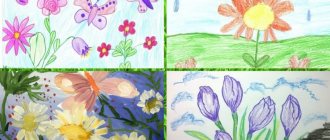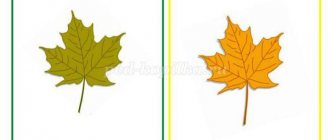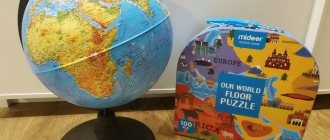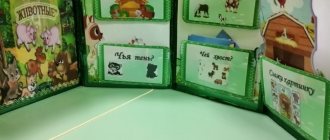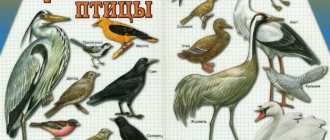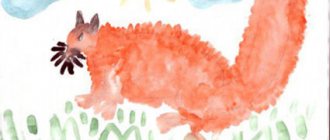TRIZ games for children: developing systems thinking
Interesting games are loved not only by children, but also by adults. Especially if to carry them out you don’t have to rummage through closets looking for the right part, buy expensive plastic characters and create the illusion of interest. This is why I love TRIZ: for its simplicity, accessibility, variability, and especially for myself in these games - inspired, inquisitive, omniscient, sometimes cunning, inventive and lively.
Games based on the theory of solving inventive problems help me achieve my main goal - to live in joy always and everywhere. Unfortunately, the mother of three little boys does not always succeed in this. For example, we went to a sanatorium for treatment, and for a long time, but we took only one suitcase with us. And, of course, not even half of the “most essential things for gaming” fit in there. But several problems remained in my memory. They saved the sanatorium from destruction!
This time we mastered system games - those that help us imagine our huge world as a whole complex system of component parts, particles and bits.
"What's in what?"
A game with this name can be illustrated with the help of our family. We have a ten-month-old brother who is constantly under the cheerful and perky pressure of a six-year-old and a four-year-old. He is part of the family system, which includes mom, dad, Ilya, Slava and, in fact, the baby. Our system is part of two others - families of grandparents. "Wow! How interesting,” said the son, and we began to transfer this to all objects and phenomena around us.
“Here is the button. She is part of the switch. And he is one of the elements of the electrical circuit of the sanatorium, and is also a part of the room. Where else could there be a button? – “In the TV remote control, in the tape recorder, on the kettle and water cooler. All the devices we use in the treatment room have buttons like this!” – Ilya and Slava summed up.
At this time, a baby was crawling past, holding a ribbon from his mother’s cosmetic bag in his fist. “What could the tape be a part of? That's right, cosmetic bags! And what else?” – I asked. The sons quickly came up with different ideas: “Part of the girls’ hair in kindergarten, part of the clothes, part of the decoration at the holiday. “And they added, “Do you remember, mom, sometimes the trees in the mountains are all covered in ribbons?”
This game is very simple - it is suitable for children from three years old, but at the same time it can easily be turned into a complex one.
"What I Was - What I Became"
This is the name of another game that has been occupying our minds for more than two months. Once we were sitting by the window in the dark, it was snowing. -What will he become? - Snowdrifts. - And the snowdrifts? - Labyrinths. - And then? – Spring will come, and the labyrinthine snowdrifts will melt, turn into streams, which will dry up and become clouds. - Or? “Or the labyrinths will be covered with new snow, and they will become huge snowdrifts.”
You can start playing with the simplest thing: if there was a puppy, there will be a dog; there was a foal - it will become a horse. We made a chain about a person: boy - youth - man - grandfather.
“What was - what has become” - for me this is a very deep game. It shows not only the different properties of objects, its changes over time, but also the change of everything in the world relative to some object. Often, when we started playing this game, my eldest son and I would go into deep discussions about nature, man, the greatness of the world and, in general, about the meaning of our existence. Four-year-old Slava often stopped us with a new problem.
Once we even tried to “decompose” a plastic bag. I still haven’t found the answer to the question of what and when it will become.
"What comes first - what comes next"
This game complements well the previous one, “What I Was - What I Became.” It is aimed at consolidating knowledge about the seasons, parts of the day and days of the week. For example, we started with a simple question, “Today is Monday, and then?”, and gradually made them more complex. My middle child can still sometimes say “we went to the country tomorrow,” even though that was a couple of months ago. Therefore, for us, such entertainment has become part of the “obligatory program”. For the eldest child, the first discovery in this direction was a grain: it would become a sprout, then a young apple tree, a flowering one, and then a fruit-bearing tree with full-bodied apples. And someday it dries up, the owner will cut it down and chop wood, light a fire and bake potatoes.
"Earlier - Later"
This game can grow from the previous two. In it we train not only knowledge of time and the properties of some object, but also imagination, thinking, and memory. And above all, it's a great game! I read about it and spent a couple of days inventing some particularly interesting starting situation or object. Until I realized that we can take as an example everything that lies, stands, grows, and is around us. For example, we were driving along a frozen mountain river, on which a man was sitting with a fishing rod. - Hole! See, there's a hole! What happened before this? The boys immediately perked up. “Before that, there was just ice there, then a fisherman came, cleared the snow, and drilled a hole. – What happened even earlier? “Even earlier, in the fall, the river flowed. - What's next? “Then gradually the water in the hole will freeze again, and there will be an ice crust in this place, which will be covered with snow until spring.
Or another situation - construction. There was nothing here before. Dad added that there was an old wooden house, but it was demolished. Now half of the brick house has already grown. Soon it will be completed, windows and doors will be installed, a children's playground will be installed nearby, and the house will begin to be occupied. People will renovate their apartments and plant flower beds at their entrances.
“Where does he live?”
Among TRIZ games, I especially like those that involve many different answers. This brings life to my "kindergarten" children who are taught on a "right and wrong" basis. An excellent example of multivariance is reflection on the question “Where does he live?” Ask a speech therapist or psychologist who tests children for admission to first grade, where the bear lives. They will tell you - “in the den.” That's right, in the den. And no options. And our bear can live in the mountains, in a fairy tale, in a cartoon, and even on a pie.
Or, for example, a glass. Where could he be? On the table, in the cupboard, in the dishwasher, on the window if there is a dandelion in it. It can stand on a desk and be an “apartment” for pens and pencils. A small fish can live in it, or the jelly can be cooled in the refrigerator. Lots of options!
For my boys, games based on the theory of inventive problems are a great way to calm down after intense physical activity, take a break from a boring activity, learn a lot of new and interesting things, and attract the attention of their parents without creating conflict situations. We can play while preparing food, when I put the baby to bed, when we walk, drive, stand and wait. And for me this is a valuable find!
Ekaterina Fedotova, storyteller, mother of three mischievous boys
You may also be interested in::
What's Like: Lessons in Imagination.
Part 1 New Year in the laboratory: mini-party with winter experiments
Studying colors and shades: mood and character
TRIZ games for five minutes: signs. Week 2
We continue to study and communicate. This week we will continue our conversation on the topic “Signs of objects”, we will conduct observations, experiments, and even show a little trick.
Lesson 6. Signs
Preparation Prepare a bag (you can use a pillowcase) and objects made from different materials: metal, wood, plastic, glass.
Game “Magic Bag” The task is to get only wooden objects (or only metal ones) from the bag. When taking out an object, you need to name one more of its properties.
For your next activity, print out the activity cards. Game “Find a Pair” You are given cards with objects. You need to pair them up. A pair can be based on function (for example, a broom and a dustpan), or a pair can be based on another feature. The main thing is that the child can explain his choice.
Guess riddles about objects. File "Riddles". The child must guess and find it in the room. For kids, use pictures as a guide.
Game “Find an object and shape” You are given cards with an image of an object and cards of a circle, square, triangle. You need to choose the appropriate shape for each item. The game can be made with objects: put different objects in a bag. When taking out an object, the child must match it with the corresponding card.
Lesson 7. Distorting mirror
Preparation Purchase foil cardboard or foil in advance. Activity Mirrors are everywhere, we have them in our house.
Game 1. Find all the objects in the house in which we are reflected. Game 2 Take a spoon and invite the child to look into it. On the convex side the image will be straight, on the concave side it will be inverted. This is a kind of distorting mirror effect. Let the child make this discovery himself.
How Sema and I played in mirrors - here.
Game 3 Let's play with distorting mirrors and make our own distorting mirror. First, we need foil cardboard or foil. Let's bend it so that one side is convex. And the other is concave. That is, it will turn out to be a wave. The distorting mirror is ready. Look into it. You can experiment by folding it either with the convex side or the concave side. The next step is to cut it into squares. Now glue the squares together (not tightly, but so that there is a distance of 0.2 - 0.5 mm between them, we get a kind of mirror made of squares) and we will get another crooked mirror.
Lesson 8. Observations and experience
In the first week we talked about dividing objects into living and non-living. Plants are living. But how do they eat? If you have flowers at home, then your child knows that plants need water to nourish them. Plants create nutrients from water. Let's conduct an experiment that will show how plants drink. Preparation Take Chinese lettuce leaves, a jar of water colored with food coloring.
Experience Color the water, place lettuce leaves in it and wait. The lettuce leaves will color in a few hours.
Lesson 9. Focus.
Today we will surprise the child with a magic trick.
The choice is a wet task - getting a coin without getting your hands wet https://www.youtube.com/watch?v=DLzgkvknmrs Very impressive and simple, we recommend it! Semyon was delighted with this trick. Jumping Coin This is a cute home trick that is simple and effective.
Place a small coin on the table and have someone pick it up without touching the table or the coin. Of course, even if someone volunteers to do this, they still won’t be able to. The secret of the trick: just hold your hand close to the coin and blow strongly on it from a distance of 5 centimeters. The air compressed by your breath will lift the coin and throw it into your hand. This is not possible right away, but after several exercises you can deftly perform this trick: you blow and there is a coin in your hand! Lesson 10. Legs and tails
Preparation Prepare cards with the animals you will play with. You can take animal figurines.
Game 1. Domestic and wild animals. Animals are different. For example, there are wild and domestic ones. Wild ones live in nature, and domestic ones live with humans. You are given cards with animals. The child’s task is to divide animals into domestic and wild ones, to tell about domestic ones, why this animal is needed. You can organize a game of teremok. We are building a house, each animal is knocking on the door, but it is only allowed in if the child tells us why a person needs this animal.
Game 2. Wings, paws, tail. Animals are all different: some run, some fly, etc. They are all amazing. You are given cards with animals - they need to be laid out in front of the child. Another group of cards are questionnaires. We draw one card at a time and the one who guessed the animal takes the card with the animal for himself. The player with the most animals wins. Reflection "Tails". Animals have tails. Why do you think? Let the child think. If he had a tail, what would he want it to be like? Interesting facts about tails: For this wonderful jumper, its tail helps to maintain balance (Kangaroo). On the tail of this representative of the cat family there is a fluffy tassel, and in it a sharp claw (Lion). Its tail is like a whip, it is great for driving away biting insects (cow). Her fluffy red tail flashes cheerfully between the green branches and serves as a parachute for its owner during jumps (squirrel). Her long fluffy tail covers up the traces of her cunning mistress well, especially in the snow (Fox). For this river builder, his tail is both a rudder and an oar, and in it he accumulates fat for the winter (beaver). This feathered healer would have fallen out of the tree in a moment if he had not held on to the trunk with his claws and, of course, his tail, which serves as a support for him (woodpecker). His tail helps him hunt. The blow of its tail is dangerous even for large animals. Covered with horny plates, it is as heavy as a log. With its powerful tail, this animal knocks the victim off his feet, throws him up and catches him with a huge toothy mouth (crocodile). Its head smoothly turns into a tail, there is not even a neck (Snake). This species of primate lost its tail as unnecessary (human)
You can download additional materials from this link.
Preschoolers
It all starts with several toys learning that they are broken and will not be hung on the Christmas tree this year. Therefore, they decide to escape to the land of New Year's toys - where it is always New Year and they love any toys, even broken ones. (The plot of the book “The Journey of New Year’s Toys” by E. Rakitina)
First of all, the children and I talked and drew a so-called geographical matryoshka doll. We start with the room we are in, then draw a house around it, the house is on the street, the street is in the city of Ramenskoye, and so on. This systemic view structures thinking well: the child understands that each “object” is located inside a more complex object
The map has been drawn and now we need to help the toys find their country. One problem: toys want to travel not in a stuffy box, but in such a way that they can “see everything.” We begin to figure out how to carry the toys so that they can look around. Here are some ideas from children:
- Carry in your hands (minus - your hands will be busy)
- Open the lid of the box (minus - it’s not convenient and can crumble)
- Put it in a bag (This is better, but the toys themselves may break even more)
- Hang it on a stick and carry it on your shoulders (Very interesting solution, we’re trying to implement it, but we also have to hold the stick with our hands)
After the guys examined themselves to look for resources on their clothes and their bodies, even stronger and more interesting solutions began to appear:
- Tie a string to a zipper
- Girls - tie to hair
- Place in your pocket and make small holes “for eyes”
I try to leave variability for such exercises so that children can try any of the invented methods or even use several, rather than trying to push them to ONE answer I have in mind.
- The next task for the children is to mentally travel around your apartment and find all the objects there that DO NOT have components. We have already touched upon the topic of finding what parts an object consists of several times. But it turns out that there are objects such as stone, or chalk, or soap, which seem to have no parts. They themselves are one big part. (Of course, modern children immediately remember atoms and molecules, but these objects really do not have larger parts)
- Wandering in search of our country, the children found a mountain of garbage: lids, candy wrappers, cans. From this stuff, everyone made a new New Year's toy. Learning to use the resources at hand. And as it turns out, garbage is an excellent resource for making jewelry.
- But while we were making all this, a magpie took away one of our toys. To get her to return the toy, you need to come up with funny phrases. We wrote down 3-letter words and then came up with a sentence so that each word in it began with a letter in the sentence:
CANCER - ripe kula k actus TOOTH - green teeth sparkle SCARF - whispers an orange to a red date (Immediately a discussion began that an orange can whisper to a date = ) )
This game is a great way to relax and take a little break from making things up. For preschoolers, such pauses are simply necessary, otherwise they get tired and fall into patterns.
- At the end we found Santa Claus, who told us that there is a land of New Year's toys in every home. This is a Christmas tree on which toys hang and which makes children happy. The children thought a little about how to correct the map they drew at the beginning: it turns out that the “country” ended up in the house!
And then they played with a cardboard Christmas tree, decorating it with small toys.
